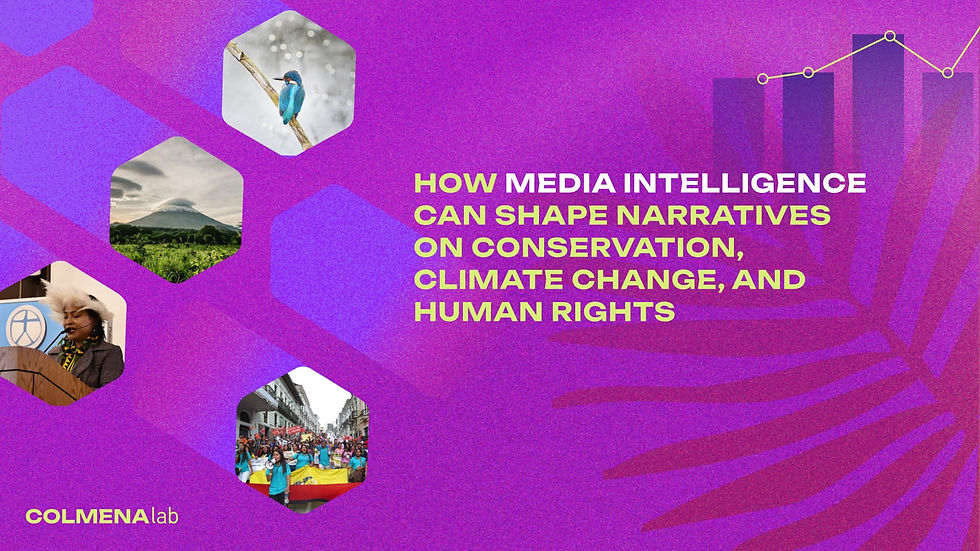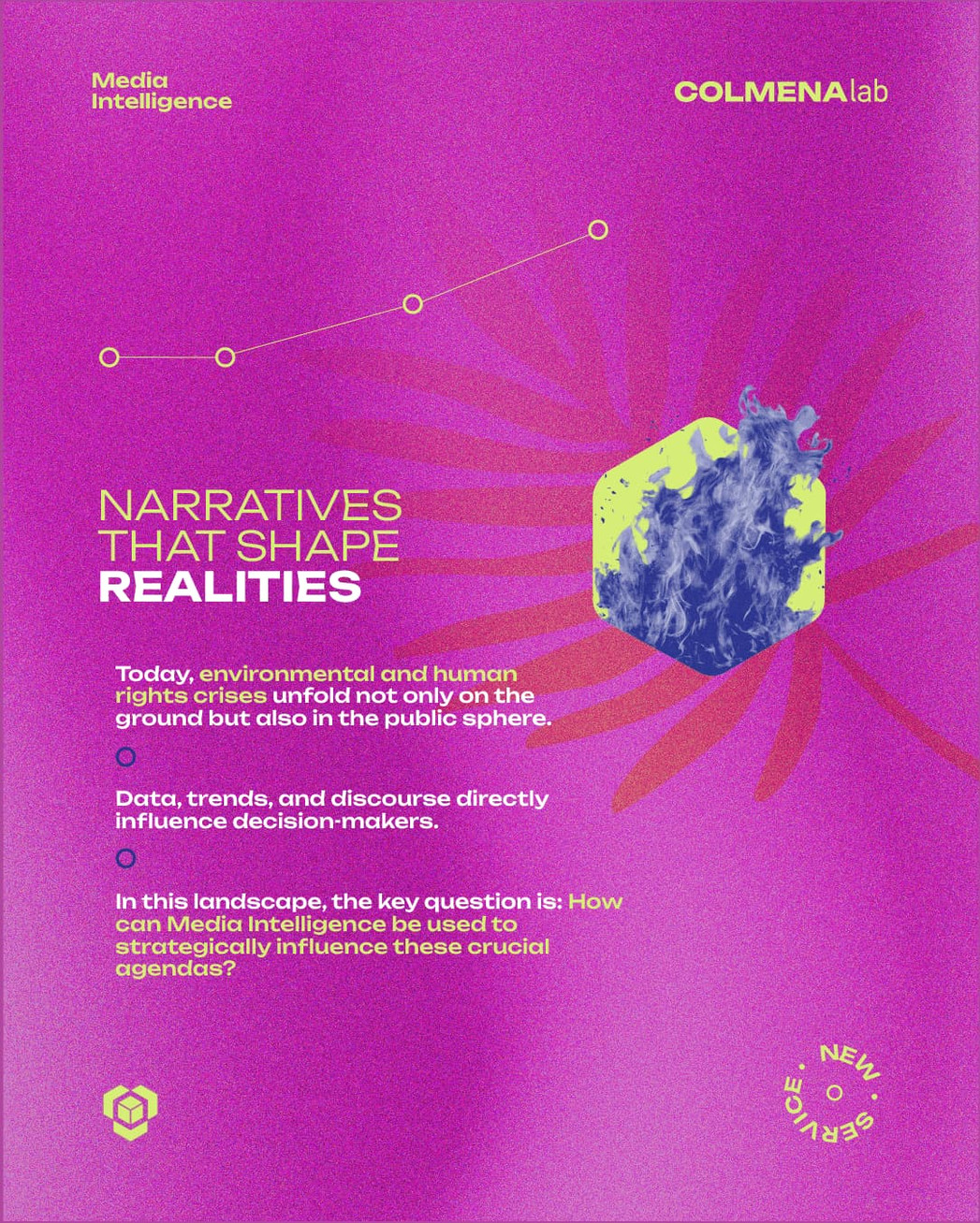How Media Intelligence Can Shape Narratives on Conservation, Climate Change, and Human Rights
- Colmena LAB
- Apr 21
- 6 min read
In an interconnected and polarized world, organizations working in conservation, climate change, human rights, international cooperation, and development face significant challenges in positioning their messages and generating real impact.
Information overload and misinformation have reached critical levels: according to figures published by the Reuters Institute in June 2024, over 60% of people worldwide distrust the news, with information flows shaped by algorithms that prioritize sensationalist and polarizing content. Additionally, public conversations evolve rapidly, driven by digital platforms where narratives can go viral within hours, temporarily or permanently altering audience perceptions.
Given this landscape, traditional communication and advocacy strategies are becoming obsolete. To be effective, organizations need an evidence-based approach with tools that allow them to anticipate trends, understand dominant narratives, and respond promptly to change.
Media Intelligence is emerging as a fundamental discipline. By combining data analysis, real-time monitoring, and adaptive communication strategies, it helps organizations navigate the complex media ecosystem, amplify their messages, and influence public agendas by leveraging opinion trends to position key issues and drive decision-making.
Beyond intuition: Towards evidence-based strategic communications
Traditionally, communications and advocacy planning have relied on experience, intuition, and qualitative analysis. While these remain essential, today’s environment demands greater precision and adaptability. According to a study by MIT, false news is 70% more likely to be shared on social media than true news and spreads up to six times faster. Additionally, digital platform algorithms favor highly emotional content, amplifying polarizing narratives and making it more challenging to disseminate evidence-based information.
In this context, media intelligence complements expert insights with large-scale data analysis, providing strategic information to:
Identify hidden patterns and trends in public discourse, distinguishing relevant signals from background noise.
Understand which messages and formats resonate most with specific audiences, optimizing narratives and dissemination channels.
Detect emerging narratives, anticipating opportunities, and managing risks before they escalate into crises.
Map key stakeholders and their influence, enabling more effective engagement with allies and decision-makers.
Accurately evaluate the impact of communication efforts, measuring not only reach but also changes in perception and policy outcomes.
These tools make advocacy efforts more effective by optimizing resources, investments, and time. However, this does not mean discarding human expertise; rather, it is about finding the optimal balance between technology, experience, creativity, and analysis.
The key to successful advocacy is to integrate these elements in a strategic way, allowing data to enhance creativity, technology to enhance experience and analytics to enhance decision-making.
Media intelligence: A discipline for understanding and action
At Colmena Lab, we do not only understand the theory behind media intelligence—we apply it daily. Staying true to our value proposition, we innovate and bring the best tools in the market to analyze, create, and optimize effective strategies and actions to influence narratives. We combine technology, expertise, and creativity to develop approaches that empower organizations to exert influence.
Media intelligence is a systematic process of listening, analyzing, and interpreting the entire information ecosystem, spanning traditional media, digital platforms, and social networks. It is not just about monitoring mentions; it is about extracting strategic insights that enable organizations to anticipate trends, respond to crises, and maximize the impact of their messages.
What Can Media Intelligence Help Understand?
Context and public perception of key issues, differentiating facts from manipulated narratives.
The dynamics of public conversations, identifying key participants, prevailing arguments, and the platforms where discussions unfold.
The effectiveness of different communication approaches, determining which formats and messages generate the most resonance.
Reputational risks and opportunities to influence the public agenda with strategic messaging.
Key Capabilities Enabled by Media Intelligence
Comprehensive active listening. Captures relevant conversations across media, social networks, forums, and digital communities, ensuring an integrated monitoring approach to key topics. Through social listening, we have developed complex narratives that include optimized messages and calls to action for highly differentiated audiences, whether in mass or specialized contexts.
Contextualized analysis. Goes beyond surface-level metrics to interpret sentiment, underlying themes, and emerging trends, providing a more precise reading of public opinion. Over the years, we have learned that while metrics provide an approximation of reach, advocacy is intrinsically linked to contextual and influence factors. Often, reaching a single decision-maker can be more valuable than reaching millions of people.
Ecosystem mapping. Identifies key actors (media, influencers, organizations, communities) and their levels of influence, facilitating more effective communication strategies. At Colmena Lab, we have honed this ability through our work in developing advocacy strategies for environmental and human rights issues, which are typically embedded in complex, multi-sector, and multi-country ecosystems.
Narrative evaluation. Analyzes how discourses around critical issues are constructed and disseminated, including detecting misinformation, manipulation campaigns, and media biases. One of the most common mistakes in advocacy campaigns is using messages that remain within an echo chamber, limiting impact and actionability. Our narratives must capture attention and shift perceptions and behaviors beyond our immediate sphere of influence.
Performance measurement. Objectively evaluates the impact of communication and advocacy initiatives, measuring not only reach but also changes in perception and policy formulation.
According to the 2024 Digital News Report by the Reuters Institute, 59% of respondents expressed concern about the accuracy of online news, reflecting a three-percentage-point increase from the previous year. This underscores the need for robust Media Intelligence to transform data into effective advocacy strategies.
This approach enables organizations not only to respond to trends but to lead them, ensuring that their messages are strategic, timely, and capable of making a real impact on public discourse and decision-making.

Applying media intelligence in complex fields: Conservation, climate, and human rights
How to Use Media Intelligence for Organizations
Media Intelligence has a profound impact on key areas where organizations seek to influence and drive real change. Let’s explore how this discipline transforms work on strategic issues such as conservation, climate change, and human rights.
Media intelligence for conservation
Applying Media Intelligence to conservation-related topics allows organizations to monitor discussions on protected areas, biodiversity, wildlife trafficking, deforestation, and sustainable resource management.
In our experience, this process has helped organizations understand public sentiment on conservation projects, counter misinformation about the impact of wildfires, extractive industries, and agro-export models, and track how extractive industries influence development narratives.

Strategies and media intelligence for climate change narratives
Over the years, we have leveraged Media Intelligence, including social listening, to understand how different audiences perceive key, complex, and contentious concepts such as “just energy transition,” “climate adaptation,” “climate migration,” “climate justice,” and “greenwashing.”
This process has enabled us to identify knowledge gaps, recurring messages, and underlying discourse. It has also allowed us to track frequently asked questions and the spread of negative arguments to refine messaging and influence key events such as climate summits.

Media intelligence for human rights advocacy
One of the most impactful applications of our work has been in the area of migration. Through social listening analysis, we have gained insights into public perceptions and debates around “refuge,” “forced displacement,” “deportations,” and “migration waves” across different countries.
This analysis enabled us to identify commonly used hate speech narratives and develop powerful counter-narratives, positioning messages and calls to action to improve timely information, raise awareness, and shift perceptions among key audiences and decision-makers.

Strategic advantages of integrating media intelligence
A systematic approach to Media Intelligence provides organizations with fundamental capabilities that optimize efficiency and reach:
Strategic Clarity. Offers a precise understanding of the operational environment and key levers of influence.
Operational Efficiency. Ensures optimal allocation of human and financial resources to the most effective tactics, maximizing impact with limited budgets.
Agility and Adaptability. Enables rapid detection of environmental shifts and strategy adjustments in response to new dynamics.
Proactive Risk Management. Facilitates the anticipation of reputational and communication crises, preparing adequate responses before they escalate.
Continuous Learning and Measurement. Provides a solid foundation for internal and external accountability, continuously improving strategies and ensuring the optimization of tactics.
Achieving these benefits requires an expert approach. At Colmena Lab, we guide you in integrating Media Intelligence to enhance your communication and advocacy projects.
Towards an informed and resilient advocacy strategy
Where narratives shape reality, global organizations cannot navigate blindly. Integrating Media Intelligence is not just about acquiring tools—it is about cultivating a culture of learning, adaptation, and evidence-based decision-making.
Are you ready to influence key conversations and drive meaningful change?
We can help.




























Comments